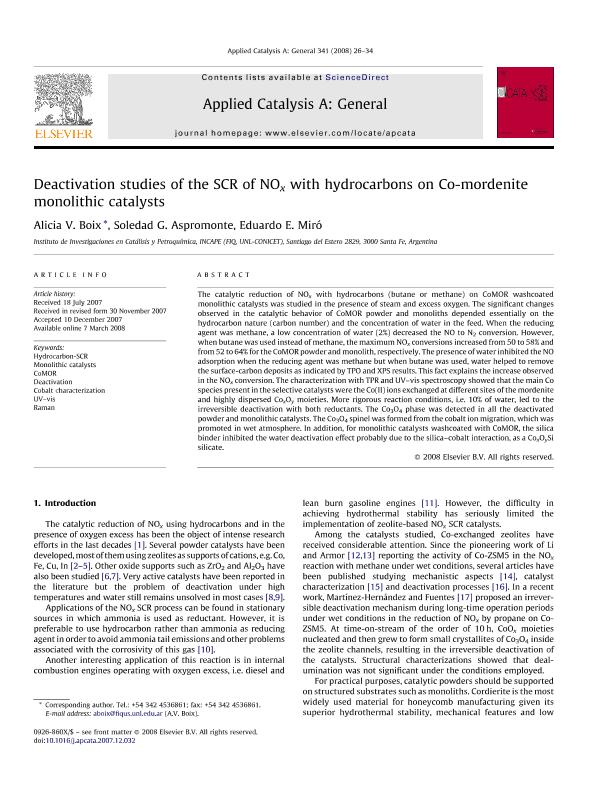Artículo
Deactivation studies of the SCR of NOx with hydrocarbons on Co-mordenite monolithic catalysts
Fecha de publicación:
06/2008
Editorial:
Elsevier Science
Revista:
Applied Catalysis A: General
ISSN:
0926-860X
Idioma:
Inglés
Tipo de recurso:
Artículo publicado
Clasificación temática:
Resumen
The catalytic reduction of NOx with hydrocarbons (butane or methane) on CoMOR washcoated monolithic catalysts was studied in the presence of steam and excess oxygen. The significant changes observed in the catalytic behavior of CoMOR powder and monoliths depended essentially on the hydrocarbon nature (carbon number) and the concentration of water in the feed. When the reducing agent was methane, a low concentration of water (2%) decreased the NO to N2 conversion. However, when butane was used instead of methane, the maximum NOx conversions increased from 50 to 58% and from 52 to 64% for the CoMOR powder and monolith, respectively. The presence of water inhibited the NO adsorption when the reducing agent was methane but when butane was used, water helped to remove the surface-carbon deposits as indicated by TPO and XPS results. This fact explains the increase observed in the NOx conversion. The characterization with TPR and UV-vis spectroscopy showed that the main Co species present in the selective catalysts were the Co(II) ions exchanged at different sites of the mordenite and highly dispersed CoxOy moieties. More rigorous reaction conditions, i.e. 10% of water, led to the irreversible deactivation with both reductants. The Co3O4 phase was detected in all the deactivated powder and monolithic catalysts. The Co3O4 spinel was formed from the cobalt ion migration, which was promoted in wet atmosphere. In addition, for monolithic catalysts washcoated with CoMOR, the silica binder inhibited the water deactivation effect probably due to the silica-cobalt interaction, as a CoxOySi silicate.
Archivos asociados
Licencia
Identificadores
Colecciones
Articulos(INCAPE)
Articulos de INST.DE INVEST.EN CATALISIS Y PETROQUIMICA "ING. JOSE MIGUEL PARERA"
Articulos de INST.DE INVEST.EN CATALISIS Y PETROQUIMICA "ING. JOSE MIGUEL PARERA"
Citación
Boix, Alicia Viviana; Aspromonte, Soledad Guadalupe; Miro, Eduardo Ernesto; Deactivation studies of the SCR of NOx with hydrocarbons on Co-mordenite monolithic catalysts; Elsevier Science; Applied Catalysis A: General; 341; 1-2; 6-2008; 26-34
Compartir
Altmétricas




